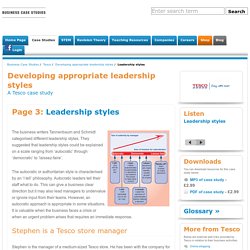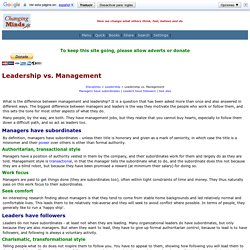

Transformational Leadership: How These Leaders Inspire and Motivate. Have you ever been in a group where someone took control of the situation by conveying a clear vision of the group's goals, a marked passion for the work, and an ability to make the rest of the group feel recharged and energized?

This person just might be what is called a transformational leader. Transformational leadership is a type of leadership style that can inspire positive changes in those who follow. Transformational leaders are generally energetic, enthusiastic, and passionate. Transformational Leadership. School leaders engage in transformative leadership, in which they intentionally become critically aware of their own tacit assumptions and expectations and assess their significance and consequence in decision making.

Transformative leaders engage in reflective processes that enable self-evaluation of personal values, beliefs, and experiences, and they intentionally promote the conditions and experiences for transformation in their staff. This includes nurturing the voices of others and building their capacity to take leadership in the school community. Leaders have developed the ability to interrupt inequitable practice, to use inquiry as a lens for equity , to show courage and persistence, to develop social and emotional intelligences among staff and students, to learn from diverse forms of knowledge and experience, and to examine individual and institutional culture as it relates to equity and anti-bias.
Www.ascd.org/ASCD/pdf/journals/ed_lead/el_199202_leithwood.pdf. 9 Tips for Communicating Decisions You Don't Agree With - Insperity. A change in business hours, layoffs, a reduction in benefits, a department reorganization, an elimination of bonuses, elimination of casual Fridays: Change in business is as relentless as it is inevitable.

While the rationale for such changes may be for the good of the company, sometimes these decisions are unpopular with your employees. And even if you disagree with the changes yourself, often, these decisions aren’t solely up to you. So, you’re left with a daunting task: Communicating a decision to your employees that you don’t personally agree with. Leadership - Engage your Team - Create a Culture of Engagement. 5 Priorities For Transformative Schools. 5 Priorities For Transformative Schools This post has been republished from a previous post by Thom Markham Imagine this scenario.

All 50 states approve the Common Core State Standards and, in an unprecedented burst of transnational cooperation, 50 other countries adopt the same standards. Miraculously, the world now operates according to a single set of learning outcomes. The media reports an astounding development: A resolution co-sponsored by the U.S., China, and Finland has been introduced to amend the UN Charter by including the (newly named) Common Core International Standards as the learning goals for the 21st Century. 4 Personality Traits That Make You an Effective Leader. What makes a good leader?

Which personality traits do the best trailblazers share? Every organization has its own benchmarks for determining who would make the best head of its teams, but are those qualities really all that different? Research in the field suggests that, on a broad level, employees and employers are looking for similar characteristics in their leaders -- no matter what business they're in. The 9 Traits That Define Great Leadership. Many leaders are competent, but few qualify as remarkable.

If you want to join the ranks of the best of the best, make sure you embody all these qualities all the time. It isn't easy, but the rewards can be truly phenomenal. 1. Awareness There is a difference between management and employees, bosses and workers. Leaders understand the nature of this difference and accept it; it informs their image, their actions, and their communication. 2. 3. 4. 5. 6. Gareth Malone's Extraordinary School for Boys - Episode 1 of 3. Gareth Malone's Extraordinary School for Boys - Episode 2 of 3. Gareth Malone's Extraordinary School for Boys - Episode 3 of 3. Leadership styles - Developing appropriate leadership styles - Tesco.
The business writers Tannenbaum and Schmidt categorised different leadership styles.

They suggested that leadership styles could be explained on a scale ranging from ‘autocratic’ through ‘democratic’ to ‘laissez-faire’. The autocratic or authoritarian style is characterised by an ‘I tell’ philosophy. Autocratic leaders tell their staff what to do. This can give a business clear direction but it may also lead managers to undervalue or ignore input from their teams. Golemans Six Leadership Styles. Improving School Leadership The toolkit. Learning to Change-Changing to Learn. Coaching: How not to do it! Daniel Goleman. Leadership vs. Management. Disciplines > Leadership > Leadership vs.

Management Managers have subordinates | Leaders have followers | See also. What Successful People Do With The First Hour Of Their Work Day. Remember when you used to have a period at the beginning of every day to think about your schedule, catch up with friends, maybe knock out a few tasks?

It was called home room, and it went away after high school. But many successful people schedule themselves a kind of grown-up home room every day. You should too. The first hour of the workday goes a bit differently for Craig Newmark of Craigslist, David Karp of Tumblr, motivational speaker Tony Robbins, career writer (and Fast Company blogger) Brian Tracy, and others, and they’ll tell you it makes a big difference. Team Leader Funny. Team Building Activities. Five Kinds Of Leadership Styles. Stephen Covey: Goals and Priorities. 5 Waves of Trust - Stephen M.R. Covey. Work-Life Balance Video : Five balls of life. Leadership Styles & Ethics. 7 Ways to ReWire Your Brain and Become a Better Leader. Over the last few decades, studies in neuroscience have shown that you can literally physically rewire your brain.

You can change the “default network” you were born with, the one that ensured the survival of our primitive ancestors who lived in a very different world. Our “fight-flight” reaction and strong memory for painful experiences are hardwired from birth. Our brains detect negative information faster than positive information and are drawn to bad news. This hardwiring is further reinforced as we grow up because our negative experiences leave an indelible trace in our brain. The brain continues to learn and change itself throughout our life. A “TO-BE” List for Aspiring Leaders by Angela Maiers. ”Being’ and ‘doing’ are inseparable aspects of your presence and influence. -author unknown I have the privilege each year of speaking to auditoriums full of aspiring young leaders, anxious to go out into the world and make their mark.
They are looking for the “book”, the “roadmap” , the “words or wisdom” that will guide them to the things they need “TO-DO” next. Top Ten Leadership Tips. Are You a Leader? -Motivating. 40 Leader Speeches in 2 Mins. The 6 People You Need in Your Corner. How to Win Friends and Influence People by Dale Carnegie. Action Plans - Project Management Tools from MindTools. Small Scale Planning Simple projects can be completed with simple plans. Four Stages for Team Effectiveness by Techdoer Times. A few years ago, I was part of a software development group stressed by a combination of challenges. The first was our ability to quickly assemble small effective teams to take on an increasing amount of short term consulting assignments. The second was ensuring that these same people could divide their attention and continue their contribution to a core team focused on a longer term and more strategic software product. As a budding project manager in charge of both teams, I grasped at anything that could help me better understand the team-dynamics we would experience over the coming months.
Source: Unknown I stumbled upon Bruce Tuckman’s, 5-stages of group development model (a.k.a. forming, storming, norming, performing, adjourning), which despite it’s age, and simplicity, proved timeless in helping me understand the maturity of the transient and core teams I was managing. Four Stages for Team Effectiveness I’m proposing the following new model for effective team growth: Self-Organize.